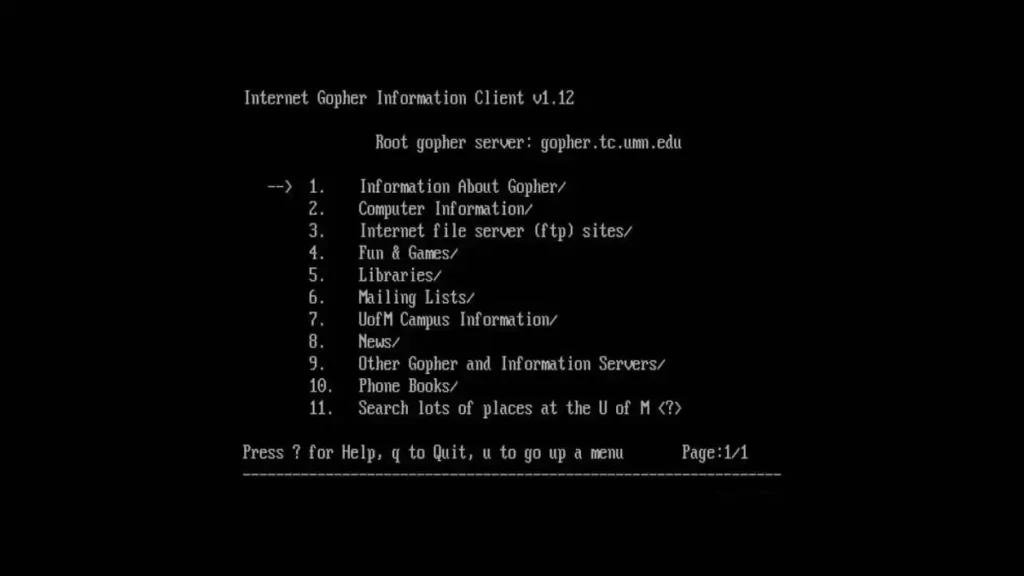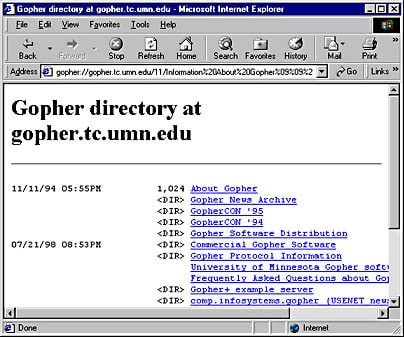Before the World Wide Web spun its worldwide web, Gopher existed as a pioneering protocol for organizing and retrieving documents over the internet. Developed in 1991 at the University of Minnesota, named after the school’s mascot and the state’s designation as the “Gopher State,” Gopher provided a hierarchical, menu-driven interface to access text files, articles, and other documents.
Table of Contents:
- What was Gopher?
- The Rise of Gopher
- The Transition to the World Wide Web
- Gopher Today: A Nostalgic Niche
- Conclusion
- References

1. What was Gopher?
Gopher emerged in the early days of the internet as a novel way to organize and access information. Picture a library’s card catalog, but digital and expansive, stretching across the globe. This was Gopher, developed in 1991 by a team at the University of Minnesota. Unlike the visually driven World Wide Web we know today, Gopher was text-based, offering a streamlined, menu-driven interface. Users navigated through menus to find documents, articles, and other resources. The beauty of Gopher lay in its simplicity and efficiency. It worked on a client-server model, where Gopher servers hosted content and users accessed it through Gopher clients. This straightforwardness made Gopher a go-to resource for sharing academic and research materials, particularly in an era when the internet’s potential was just being realized.
1.1 How It Worked
Gopher was similar to another Internet protocol, File Transfer Protocol (FTP), because it remotely accessed files over a TCP/IP internetwork such as the Internet. But while an FTP site exists on only one server and there can be many different FTP sites, there is really only one distributed Gopher file system. The Gopher file system was a single collection of all Gopher servers in the world (although private Gopher subnetworks also existed).

Each Gopher server could act as the root of the hierarchical distributed file system. To access a file or document, a person using a Gopher client (a standard Web browser such as Microsoft Internet Explorer will do) types the Uniform Resource Locator (URL) of an accessible Gopher server. For example, gopher://gopher.tc.umn.edu takes the user to a Gopher server for the University of Minnesota (where Gopher originated). The Gopher file system is presented as a series of folders, each of which can contain:
- More folders
- Individual documents
- Links to other Gopher servers (displayed as folders)
Users then work their way down the “gopher hole” (to use the metaphor) until they locate the document they want, and then they display or download it. They can also use a search tool developed at the University of Nevada called Veronica (Very Easy Rodent-Oriented Netwide Index to Computerized Archives) to perform keyword searches to locate documents on the worldwide Gopher network.
2. The Rise of Gopher
2.1 Development and Design
Gopher’s design was deceptively simple: it organized data into a globally distributed file system accessible through a client-server architecture. This simplicity, combined with its efficient protocol, made Gopher an attractive option for early internet users, particularly academic and research communities.
2.2 Adoption and Use Cases
By the early 1990s, universities and libraries worldwide adopted Gopher. It was particularly useful for sharing academic papers, datasets, and educational resources. Its structured approach allowed users to navigate through directories to find the information they needed quickly.
3. The Transition to the World Wide Web
3.1 Advantages of the WWW
The World Wide Web, developed by Sir Tim Berners-Lee, offered a more dynamic and interconnected user experience. HTML (HyperText Markup Language) and URLs (Uniform Resource Locators) introduced the ability to link documents and resources in a way Gopher couldn’t match. As web browsers became more sophisticated, the visual and interactive capabilities of the WWW far outstripped the text-based, menu-driven interface of Gopher.
3.2 Decline of Gopher
The rise of the WWW and its inherent advantages inevitably led to the decline of Gopher. While Gopher had dominated the early ’90s as a structured, efficient means of accessing information, it began to lose ground for several reasons.
3.2.1 Licensing and Openness
A significant factor in Gopher’s decline was the University of Minnesota’s decision to charge licensing fees for commercial use of its Gopher server software. This move contrasted sharply with the open and free nature of WWW technologies, which were widely accessible and not subject to licensing fees. The internet community, which highly valued openness and accessibility, naturally gravitated towards the World Wide Web.
3.2.2 Technological Evolution
As the WWW evolved, web browsers became more sophisticated, integrating features like JavaScript, which allowed for dynamic content and interactive web applications. This evolution further widened the gap between the capabilities of the WWW and Gopher. The text-based, menu-driven interface of Gopher, while efficient, could not compete with the engaging, multimedia experiences offered by the web.
3.2.3 The Shift in User Expectations
User expectations also played a crucial role in the transition. The early internet users, accustomed to Gopher’s simplicity, soon found the rich multimedia and interactive capabilities of the WWW more compelling. As content creators and organizations began to prefer the WWW for its versatility and reach, Gopher’s user base and content offerings dwindled.
In summary, the transition from Gopher to the World Wide Web was driven by a combination of technological innovations, strategic missteps, and changing user expectations. The WWW’s ability to offer a more engaging, interconnected, and visually rich experience aligned with the growing demand for dynamic content and global connectivity. While Gopher played a pivotal role in the early development of internet-based information sharing, the legacy of its simplicity and efficiency is overshadowed by the comprehensive capabilities and universal adoption of the World Wide Web.
4. Gopher Today: A Nostalgic Niche
4.1 Current Use and Community
Despite its decline, Gopher has not disappeared. A small but passionate community continues to maintain Gopher servers and clients. These enthusiasts appreciate Gopher’s simplicity, low bandwidth requirements, and the nostalgia of a simpler internet era.
4.2 Technical and Cultural Significance
Gopher remains a fascinating study in the evolution of internet technologies. It exemplifies a period when multiple protocols competed to shape the internet’s future, reminding us of the importance of open standards and the impact of design choices on technology adoption.
5. Conclusion
Gopher’s legacy is a testament to the rapid evolution of digital technologies and the ever-changing landscape of the internet. While it may no longer be a mainstream tool, its influence on early internet development and its continued use by a dedicated community highlight the diverse ways people have sought to organize and access information online.
6. References
6.1 Books
- “Where Wizards Stay Up Late: The Origins Of The Internet” by Katie Hafner and Matthew Lyon. This book provides insight into the early development of the internet, including the context in which protocols like Gopher emerged.
- “Weaving the Web: The Original Design and Ultimate Destiny of the World Wide Web by Its Inventor” by Tim Berners-Lee. Offers an authoritative perspective on the development of the WWW, contrasting it with other technologies like Gopher.
6.2 RFCs (Request for Comments)
- RFC 1436: “The Internet Gopher Protocol (a distributed document search and retrieval protocol).” This is the primary technical specification for the Gopher protocol, authored by Farhad Anklesaria, Paul Lindner, Mark McCahill, Dan Torrey, and Bob Alberti.